An Automated Method for Surface Ice/Snow Mapping Based on Objects and Pixels from Landsat Imagery in a Mountainous Region
Abstract
1. Introduction
2. Study Areas and Data Sources
2.1. Study Areas
2.2. Landsat Image
2.3. Randolph Glacier Inventory
3. Methods
3.1. Data Preprocessing
3.2. Global Extraction Based on Objects
3.3. Local Extraction Based on Pixels
3.4. Accuracy Assessment
4. Results
4.1. Surface Ice/Snow Areas Mapped Using Different Images
4.2. Accuracy Assessment of the Extraction Results
5. Discussion
5.1. The Influence of the Segmentation Scale on the Extracted Results
5.2. The Influence of the Classification Threshold on the Extracted Results
5.3. NDSI based on Landsat TM, ETM+ and OLI
6. Conclusions
Author Contributions
Funding
Acknowledgments
Conflicts of Interest
References
- Feyisa, G.L.; Meilby, H.; Fensholt, R.; Proud, S.R. Automated Water Extraction Index: A New Technique for Surface Water Mapping Using Landsat Imagery. J. Remote Sens. Environ. 2014, 140, 23–35. [Google Scholar] [CrossRef]
- Wekerle, C.; Colleoni, F.; Näslund, J.O.; Brandefelt, J.; Masina, S. Numerical reconstructions of the penultimate glacial maximum Northern Hemisphere ice sheets: Sensitivity to climate forcing and model parameters. J. Glaciol. 2016, 62, 607–622. [Google Scholar] [CrossRef][Green Version]
- Erokhina, O.; Rogozhina, I.; Prange, M.; Bakker, P.; Bernales, J.; Paul, A.; Schulz, M. Dependence of slope lapse rate over the Greenland ice sheet on background climate. J. Glaciol. 2017, 63, 568–572. [Google Scholar] [CrossRef]
- Belart, J.C.; Magnusson, E.; Berthier, E.; Pálsson, F.; Adalgeirsdottir, G.; Jóhannesson, T. The geodetic mass balance of Eyjafjallajökull ice cap for 1945–2014: Processing guidelines and relation to climate. J. Glaciol. 2019, 65, 395–409. [Google Scholar] [CrossRef]
- Tilburg, C.V.; Grissom, C.K.; Zafren, K.; Mclntosh, S.; Radwin, M.I.; Paal, P.; Haegeli, P.; Smith, W.W.; Wheeler, A.R.; Weber, D.; et al. Wilderness Medical Society practice guidelines for prevention and management of avalanche and nonavalanche snow burial accidents. J. Wildern. Environ. Med. 2017, 28, 23–42. [Google Scholar] [CrossRef]
- Gavazov, K.; Ingrisch, J.; Hasibeder, R.; Mills, R.T.; Buttler, A.; Gleixner, G.; Punpanen, J.; Bahn, M. Winter ecology of a subalpine grassland: Effects of snow removal on soil respiration, microbial structure and function. J. Sci. Total Environ. 2017, 590, 316–324. [Google Scholar] [CrossRef]
- Moreno-Gené, J.; Sánchez-Pulido, L.; Cristobal-Fransi, E.; Daries, N. The economic sustainability of snow tourism: The case of ski resorts in Austria, France, and Italy. J. Sustain. 2018, 10, 12. [Google Scholar] [CrossRef]
- Fountain, A.G.; Glenn, B.; Scambos, T.A. The changing extent of the glaciers along the western Ross Sea, Antarctica. J. Geol. 2017, 45, 1–4. [Google Scholar] [CrossRef]
- Fahnestock, M.; Scambos, T.; Moon, T.; Gardner, A.; Haran, T.; Klinger, M. Rapid large-area mapping of ice flow using Landsat 8. J. Remote Sens. Environ. 2016, 185, 84–94. [Google Scholar] [CrossRef]
- Yumashey, D.; Hope, C.; Schaefer, K.; Riemann-Campe, K.; Iglesias-Suarea, F.; Jafaroy, E.; Whiteman, G.; Young, P. Climate policy implications of nonlinear decline of Arctic land permafrost and other cryosphere elements. J. Nat. Commun. 2019, 10, 1900. [Google Scholar] [CrossRef]
- Dozier, J.; Green, R.O.; Nolin, A.W.; Painter, T. Interpretation of snow properties from imaging spectrometry. J. Remote Sens. Environ. 2009, 113, S25–S37. [Google Scholar] [CrossRef]
- Salomonson, V.V.; Appel, I. Estimating fractional snow cover from MODIS using the normalized difference snow index. J. Remote Sens. Environ. 2004, 89, 351–360. [Google Scholar] [CrossRef]
- Li, Q.; Yang, T.; Zhou, H.; Li, L. Patterns in snow depth maximum and snow cover days during 1961–2015 period in the Tianshan Mountains, Central Asia. J. Atmos. Res. 2019, 228, 14–22. [Google Scholar] [CrossRef]
- Selkowitz, D.; Forster, R. An automated approach for mapping persistent ice and snow cover over high latitude regions. J. Remote Sens. 2016, 8, 16. [Google Scholar] [CrossRef]
- Wang, X.; Yang, F.; Gao, X.; Wang, W.; Zha, X. Evaluation of Forest Damaged Area and Severity Caused by Ice-snow Frozen Disasters over Southern China with Remote Sensing. J. Chin. Geogr. Sci. 2019, 29, 405–416. [Google Scholar] [CrossRef]
- Iliyana, D.; Andrew, G. Fractional snow cover mapping through artificial neural network analysis of MODIS surface reflectance. J. Remote Sens. Environ. 2011, 12, 3355–3366. [Google Scholar]
- Warren, S.G. Optical properties of snow. J. Rev. Geophys. 1982, 20, 67–89. [Google Scholar] [CrossRef]
- Hall, D.K.; Riggs, G.A.; Salomonson, V.V.; DiGirolamo, N.E.; Bayr, K.J. MODIS snow-cover products. J. Remote Sens. Environ. 2002, 83, 181–194. [Google Scholar] [CrossRef]
- Wang, X.Y.; Wang, J.; Jiang, Z.Y.; Li, H.; Hao, X. An effective method for snow-cover mapping of dense coniferous forests in the Upper Heihe River Basin using Landsat Operational Land Imager Data. J. Remote Sens. 2015, 7, 17246–17257. [Google Scholar] [CrossRef]
- Sidjak, R.W.; Wheate, R. Glacier Mapping of the Illecillewaet Icefield, British Columbia, Canada, Using Landsat TM and Digital Elevation Data. Int. J. Remote Sens. 1996, 2, 273–284. [Google Scholar] [CrossRef]
- Shangguan, D.; Liu, S.; Ding, Y.; Ding, L.; Xiong, L.; Cai, D.; Li, G.; Lu, A.; Zhang, S.; Zhang, Y. Monitoring the Glacier Changes in the Muztag Ata and Konggur Mountains, East Pamirs, based on Chinese Glacier Inventory and Recent Satellite Imagery. J. Ann. Glaciol. 2006, 43, 79–85. [Google Scholar] [CrossRef][Green Version]
- He, G.; Xiao, P.; Feng, X.; Zhang, X.; Wang, Z.; Chen, N. Extraction Snow Cover in Mountain Areas Based on SAR and Optical Data. J. IEEE Geosci. Remote Sens. 2015, 5, 1–5. [Google Scholar]
- Elzbieta, H.; Czyzowska, W.; Willem, J.D.; Katherine, K.H.; Stuart, E.M.; Wit, T.W. Fractional snow cover estimation in complex alpine-forested envrionments using an artificial neural network. J. Remote Sens. Environ. 2015, 156, 403–417. [Google Scholar]
- Myint, S.W.; Gober, P.; Brazel, A.; Grossman-Clarke, S.; Weng, Q. Per-pixel vs. object-based classification of urban land cover extraction using high spatial resolution imagery. J. Remote Sens. Environ. 2011, 115, 1145–1161. [Google Scholar] [CrossRef]
- Philipp, R.; Tobias, B.; Claudia, N.; Frank, P. A Comparison of Pixel- and Object-Based Glacier Classification with Optical Satellite Images. IEEE J.-Stars. 2014, 3, 853–862. [Google Scholar]
- Hossain, M.D.; Chen, D. Segmentation for Object-Based Image Analysis (OBIA): A review of algorithms and challenges from remote sensing perspective. ISPRS-J. Photogramm. Remote Sens. 2019, 150, 115–134. [Google Scholar] [CrossRef]
- Wang, X.; Wang, J.; Che, T.; Li, H. Snow cover mapping for complex mountainous forested environments based on a multi-index technique. IEEE J. Sel. Top. Appl. Earth Observ. Remote Sens. 2018, 11, 1433–1441. [Google Scholar] [CrossRef]
- Thompson, J.A.; Lees, B.G. Applying object-based segmentation in the temporal domain to characterize snow seasonality. ISPRS J. Photogramm. 2014, 98, 98–110. [Google Scholar] [CrossRef]
- Yin, D.; Cao, X.; Chen, X.; Shao, Y.; Chen, J. Comparison of automatic thresholding methods for snow-cover mapping using Landsat TM imagery. Int. J. Remote Sens. 2013, 9, 6529–6538. [Google Scholar] [CrossRef]
- WINTHER, J. Landsat TM derived and in situ summer reflectance of glaciers in Svalbard. J. Polar Res. 1993, 12, 37–55. [Google Scholar] [CrossRef]
- Guo, W.; Liu, S.; Xu, J.; Wu, L.; Shangguan, D.; Yao, X.; Wei, J.; Bao, W.; Yu, P.; Liu, Q.; et al. The second Chinese glacier inventory: Data, methods and results. J. Glaciol. 2015, 61, 357–372. [Google Scholar] [CrossRef]
- Hui, F.; Li, X.; Zhao, T.; Shokr, M.; Heil, P.; Zhao, J.; Liu, Y.; Liang, S.; Cheng, X. Semi-automatic mapping of tidal cracks in the fast ice region near Zhongshan station in east Antarctica using landsat-8 OLI imagery. J. Remote Sens. 2016, 8, 242. [Google Scholar] [CrossRef]
- Khan, A.; Naz, B.S.; Bowling, L.C. Separating snow, clean and debris covered ice in the Upper Indus Basin, Hindukush-Karakoram-Himalayas, using Landsat images between 1998 and 2002. J. Hydrol. 2015, 521, 46–64. [Google Scholar] [CrossRef]
- Tad, P.; Anthony, A.; Bliss, A.; Tobias, B.; Cogley, J.G. The Randolph glacier inventory: A globally complete inventory of glaciers. J. Glaciol. 2014, 221, 537–552. [Google Scholar]
- Paul, F.; Holger, F.; Tobias, B. A new satellite-derived glacier inventory for western Alaska. J. Ann. Glaciol. 2011, 59, 135–143. [Google Scholar]
- Hua, T.; Zhao, W.; Liu, Y.; Wang, S.; Yang, S. Spatial Consistency Assessments for Global Land-Cover Datasets: A Comparison among GLC2000, CCILC, MCD12, GLOBCOVER and GLCNMO. J. Remote Sens. 2018, 11, 1846. [Google Scholar] [CrossRef]
- Zhu, Z.; Woodcock, C.E. Object-based cloud and cloud shadow detection in Landsat imagery. J. Remote Sens. Environ. 2012, 118, 83–94. [Google Scholar] [CrossRef]
- Liu, T.; Abd-Elrahman, A. Multi-view object-based classification of wetland land covers using unmanned aircraft system images. J. Remote Sens. Environ. 2018, 216, 122–138. [Google Scholar] [CrossRef]
- Ursula, C.B.; Peter, H.; Gregor, W.; Iris, L.; Markus, H. Multi-resolution, object-oriented fuzzy analysis of remote sensing data for GIS-ready information. ISPRS J. Photogramm. 2004, 58, 239–258. [Google Scholar]
- Bleau, A.; Leon, L.J. Watershed-based segmentation and region merging. J. Comput. Vis. Image Underst. 2000, 77, 317–370. [Google Scholar] [CrossRef]
- Li, P.; Xiao, X. Multispectral image segmentation by a multichannel watershed-based approach. Int. J. Remote Sens. 2007, 28, 4429–4452. [Google Scholar] [CrossRef]
- Levner, I.; Zhang, H. Classification-driven watershed segmentation. J. IEEE Trans. Image Process. 2007, 16, 1437–1445. [Google Scholar] [CrossRef] [PubMed]
- Choubin, B.; Solaimani, K.; Roshan, M.H.; Malekian, A. Watershed classification by remote sensing indices: A fuzzy c-means clustering approach. J. Mt. Sci. 2017, 14, 2053–2063. [Google Scholar] [CrossRef]
- Congalton, R.G. A review of assessing the accuracy of classifications of remotely sensed data. J. Remote Sens. Environ. 1991, 37, 35–46. [Google Scholar] [CrossRef]
- Zhao, H.; Chen, F.; Zhang, M. A Systematic Extraction Approach for Mapping Glacial Lakes in High Mountain Regions of Asia. IEEE J. Sel. Top. Appl. Earth Observ. Remote Sens. 2018, 11, 2788–2799. [Google Scholar] [CrossRef]
- Ghosh, A.; Joshi, P.K. A comparison of selected classification algorithms for mapping bamboo patches in lower Gangetic plains using very high resolution WorldView 2 imagery. Int. J. Appl. Earth Obs. Geoinf. 2014, 26, 298–311. [Google Scholar] [CrossRef]
- Wang, Z.; Lu, C.; Yang, X. Exponentially sampling scale parameters for the efficient segmentation of remote-sensing images. Int. J. Remote Sens. 2018, 39, 1628–1654. [Google Scholar] [CrossRef]
- Drăguţ, L.; Csillik, O.; Eisank, C.; Tiede, D. Automated parameterisation for multi-scale image segmentation on multiple layers. ISPRS-J. Photogramm. Remote Sens. 2014, 88, 119–127. [Google Scholar] [CrossRef]
- Mountrakis, G.; Im, J.; Ogole, C. Support vector machines in remote sensing: A review. J. ISPRS-J. Photogramm. Remote Sens. 2011, 66, 247–259. [Google Scholar] [CrossRef]
- Sezgin, M.; Sankur, B. Survey over image thresholding techniques and quantitative performance evaluation. J. Electron. Imaging 2004, 13, 146–166. [Google Scholar]
- Selkowitz, D.J.; Forster, R.R. Automated mapping of persistent ice and snow cover across the western US with Landsat. ISPRS-J. Photogramm. Remote Sens. 2016, 117, 126–140. [Google Scholar] [CrossRef]
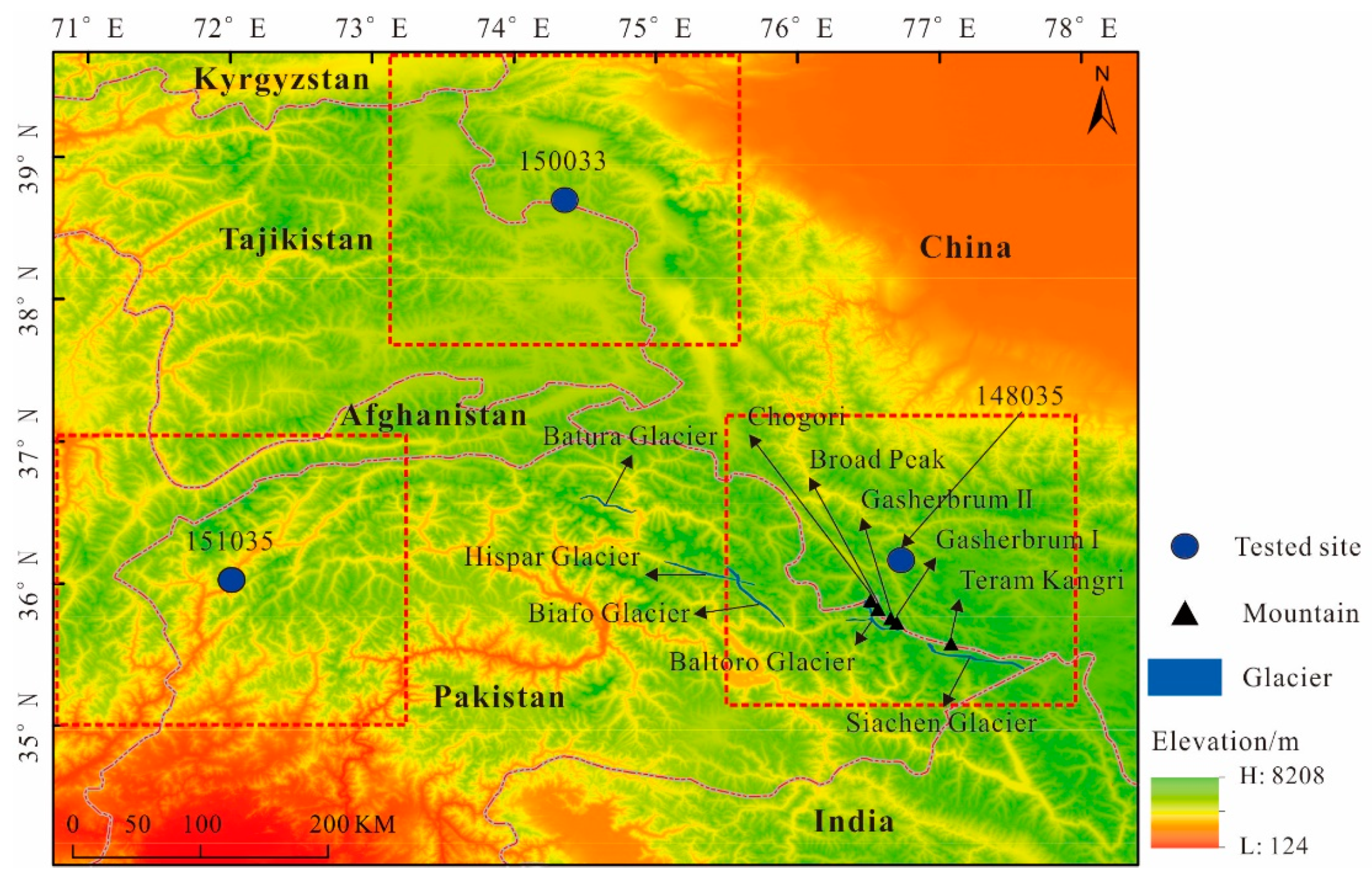
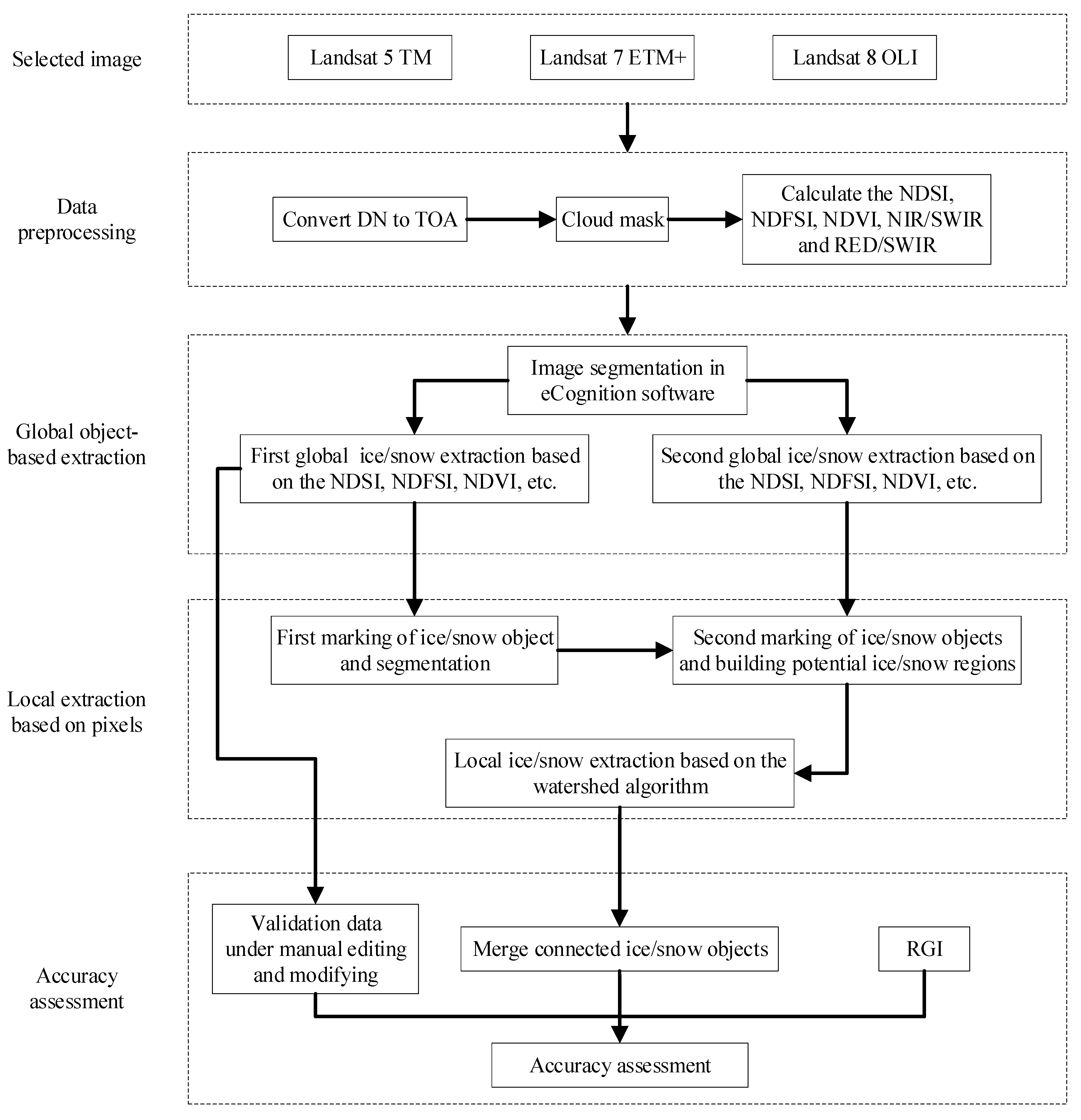
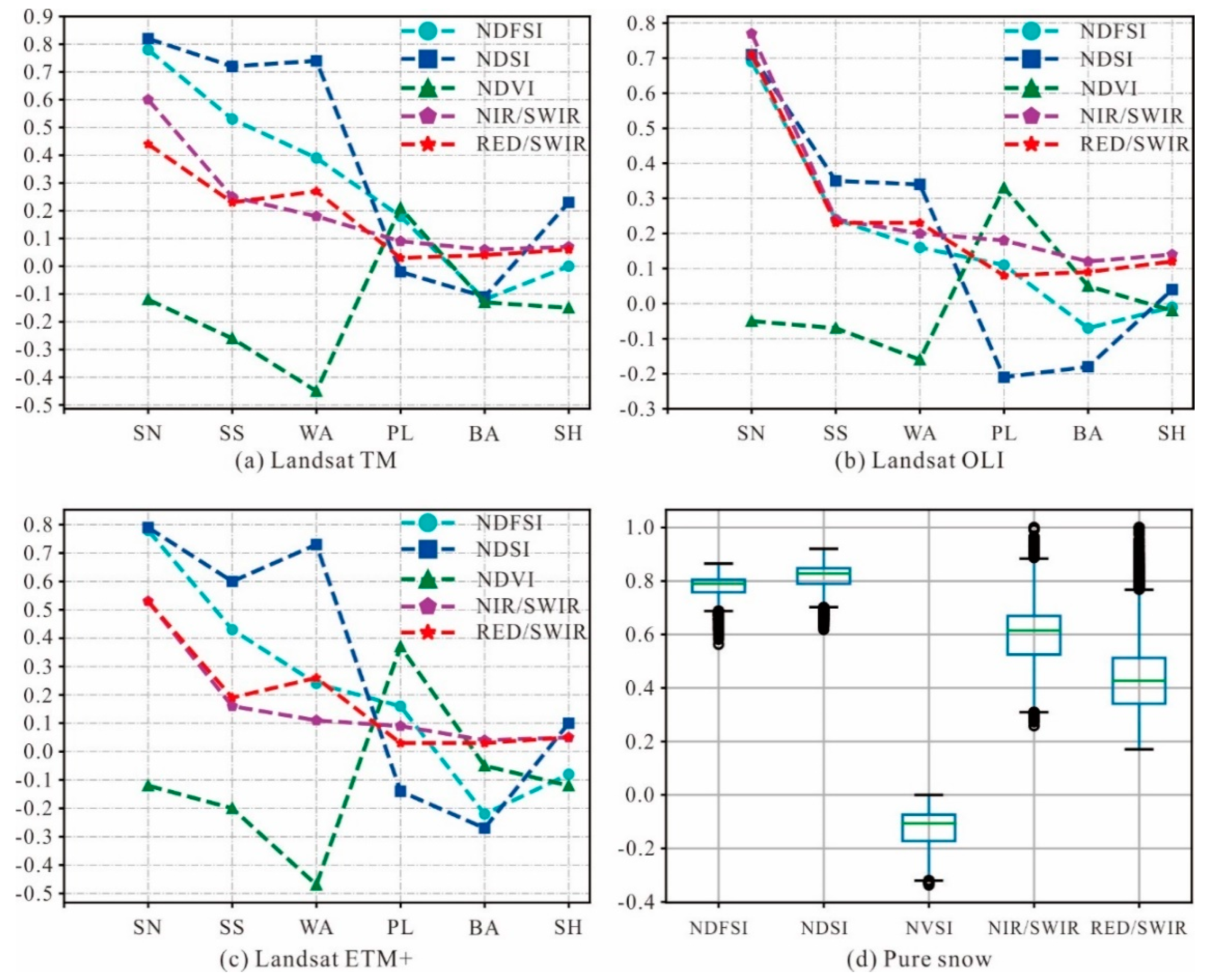
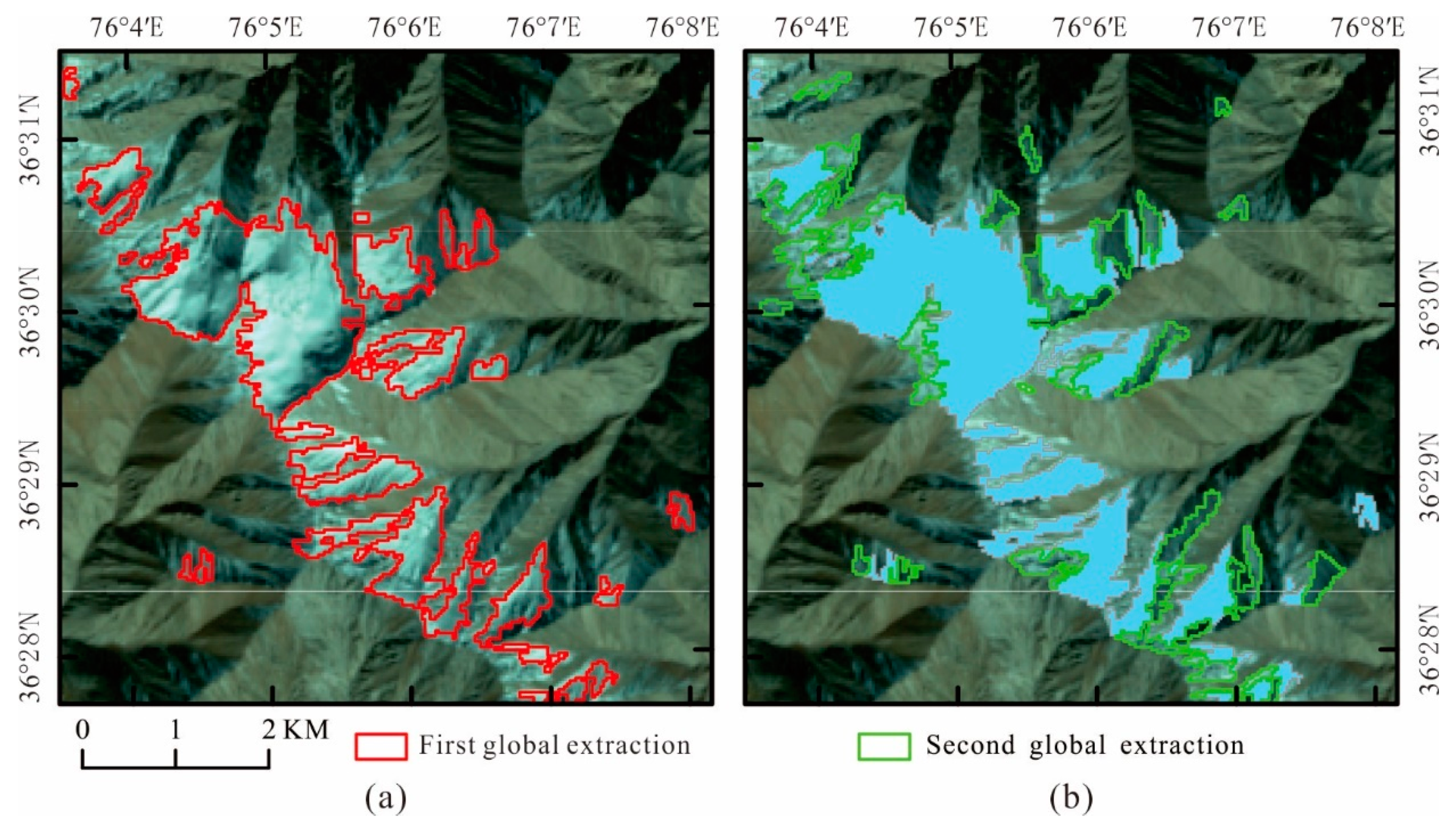
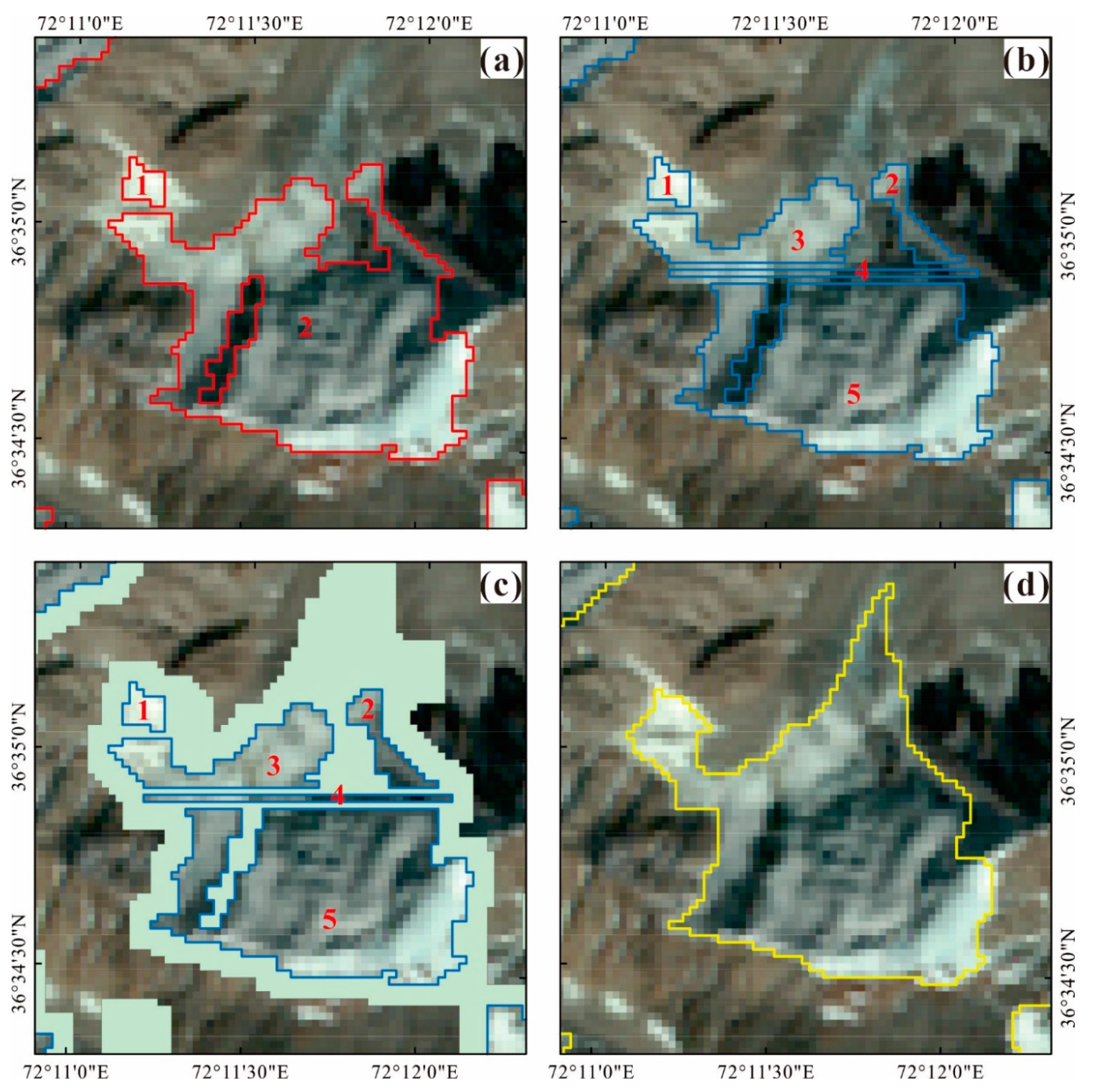
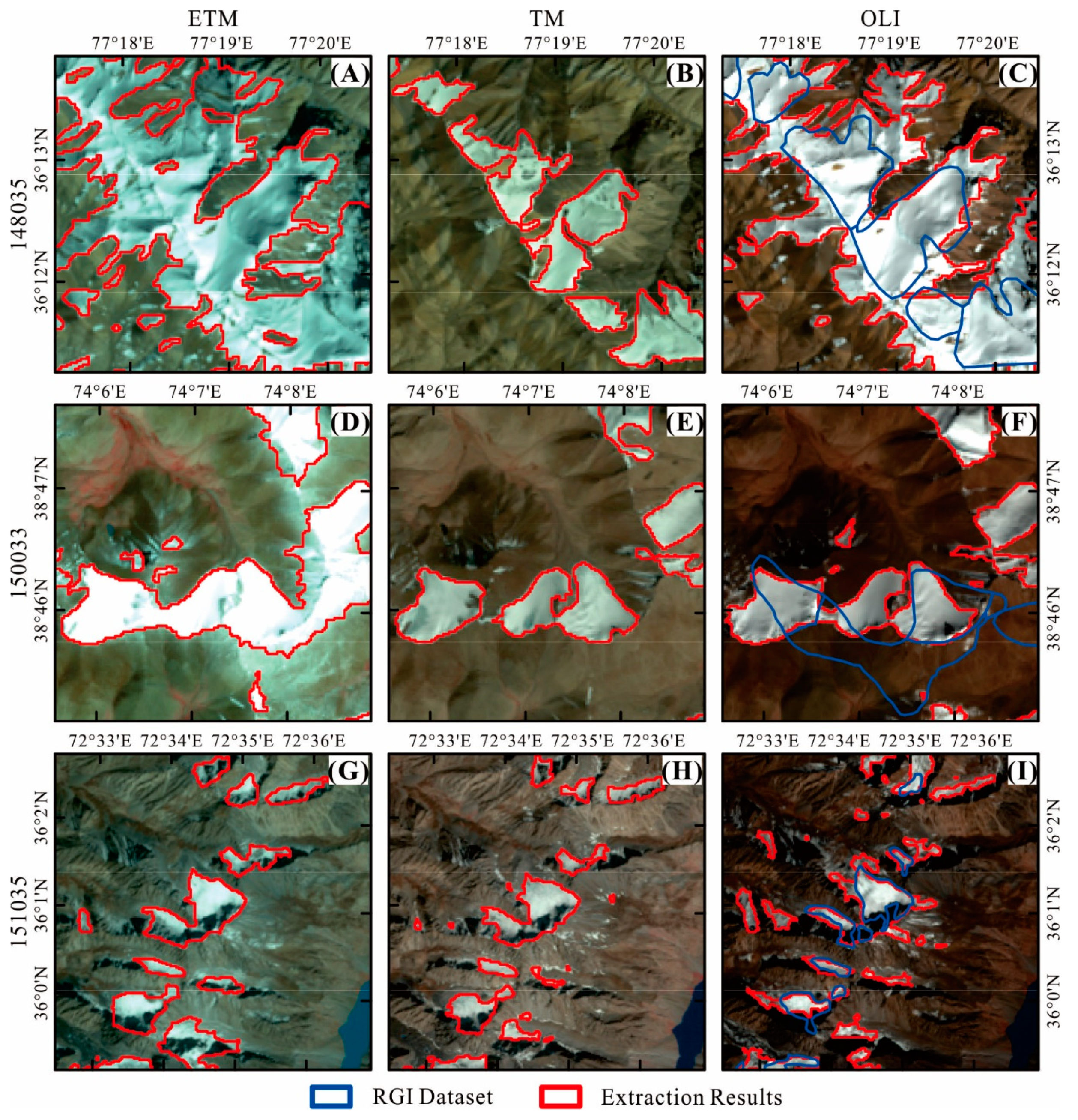
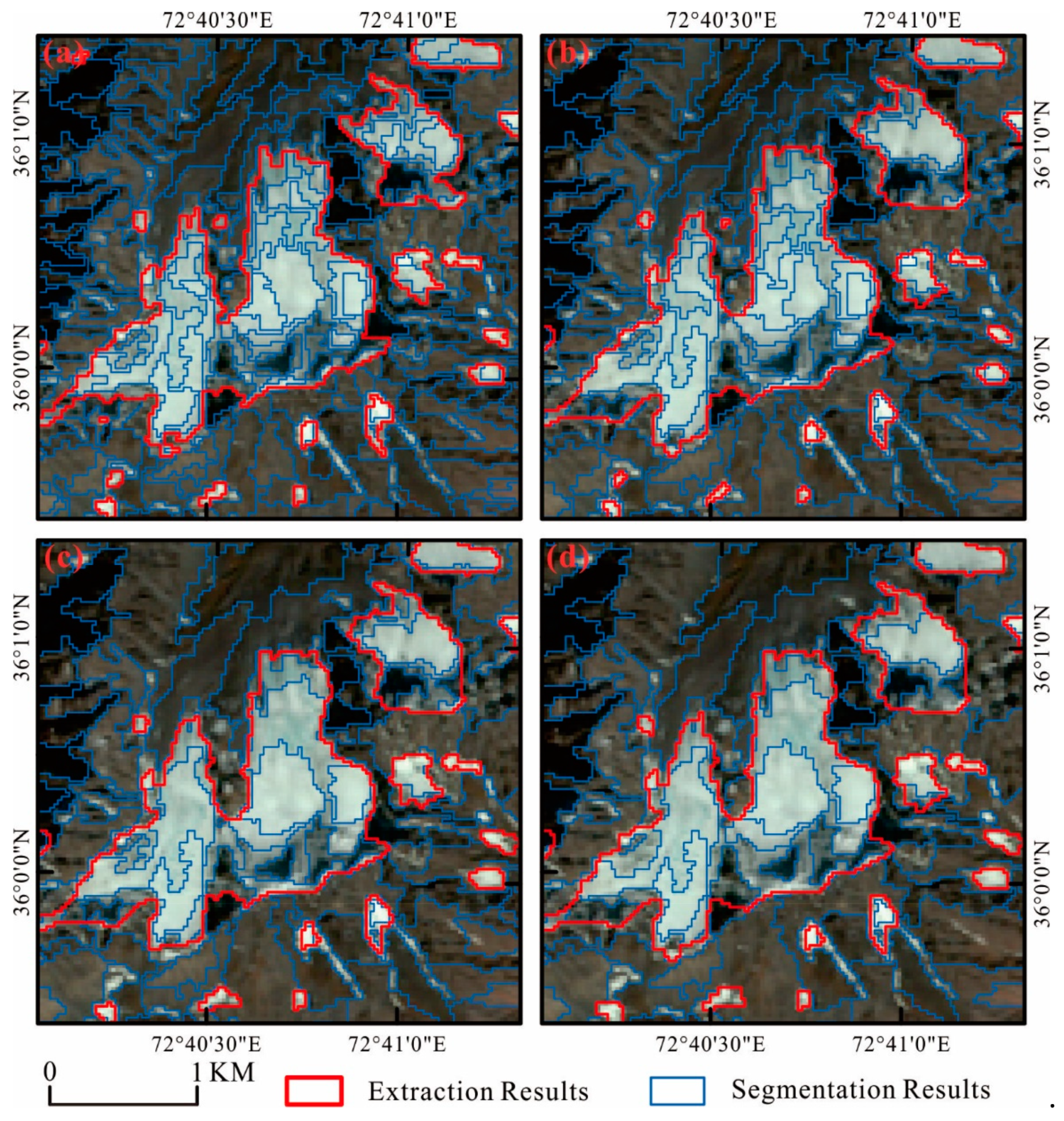
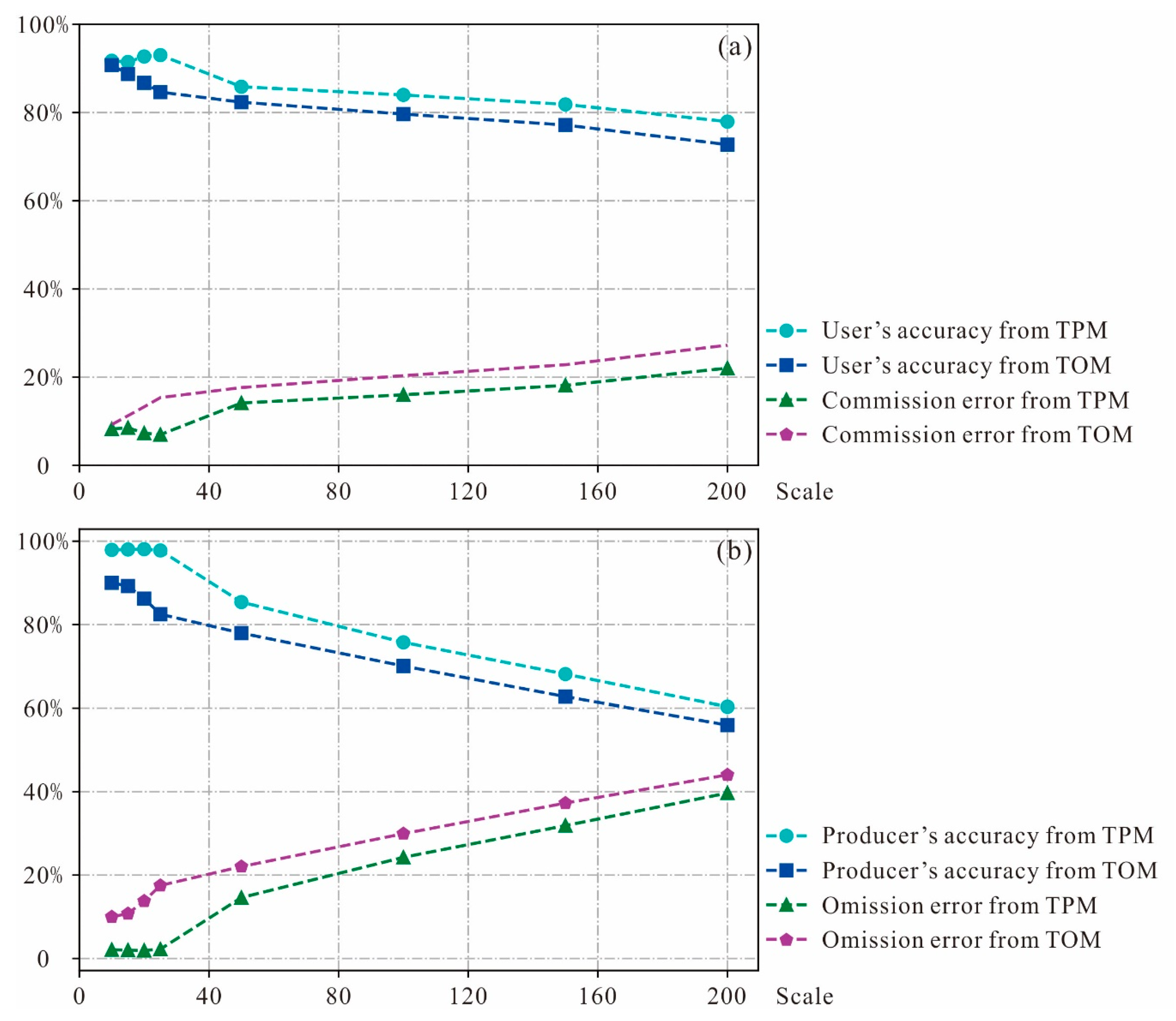
| Number. | ID | Sensor | Scene Cloud | Latitude/Longitude |
|---|---|---|---|---|
| A | LE71480352002285SGS00 | ETM+ | 2.00% | 36.032425/76.7452 |
| B | LT51480352010235KHC00 | TM | 2.00% | 36.03508/76.740235 |
| C | LC81480352014262LGN01 | OLI | 2.46% | 36.03097/76.78091 |
| D | LE71500331999227EDC00 | ETM+ | 3.00% | 38.900755/74.50665 |
| E | LT51500332009262KHC00 | TM | 4.00% | 38.89796/74.518615 |
| F | LC81500332014276LGN01 | OLI | 0.91% | 38.893145/74.53309 |
| G | LE71510352001271SGS00 | ETM+ | 1.00% | 36.03413/72.04427 |
| H | LT51510352009269KHC00 | TM | 1.00% | 36.037105/72.11567 |
| I | LC81500332015286LGN01 | OLI | 1.56% | 36.03145/72.142975 |
| Image | Class | User’s Accuracy (%) | Producer’s Accuracy (%) | Commission Error (%) | Omission Error (%) | Overall Accuracy (%) | Kappa Coefficient |
|---|---|---|---|---|---|---|---|
| A | Snow | 95.00 | 99.14 | 5.00 | 0.86 | 98.33 | 0.96 |
| Non-snow | 99.67 | 98.03 | 0.33 | 1.97 | |||
| B | Snow | 91.96 | 99.17 | 8.04 | 0.83 | 98.20 | 0.94 |
| Non-snow | 99.80 | 97.97 | 0.20 | 2.03 | |||
| C | Snow | 96.09 | 99.26 | 3.91 | 0.74 | 98.63 | 0.97 |
| Non-snow | 99.70 | 98.38 | 0.30 | 1.62 | |||
| D | Snow | 96.13 | 99.20 | 3.87 | 0.80 | 99.42 | 0.97 |
| Non-snow | 99.89 | 99.45 | 0.11 | 0.55 | |||
| E | Snow | 93.61 | 98.14 | 6.39 | 1.86 | 99.67 | 0.96 |
| Non-snow | 99.93 | 99.73 | 0.07 | 0.27 | |||
| F | Snow | 95.27 | 98.59 | 4.73 | 1.41 | 99.67 | 0.97 |
| Nonsnow | 99.92 | 99.73 | 0.08 | 0.27 | |||
| G | Snow | 89.55 | 99.12 | 10.45 | 0.88 | 98.59 | 0.93 |
| Non-snow | 99.89 | 98.53 | 0.11 | 1.47 | |||
| H | Snow | 91.46 | 98.01 | 8.54 | 1.99 | 99.39 | 0.94 |
| Non-snow | 99.88 | 99.47 | 0.12 | 0.53 | |||
| I | Snow | 94.26 | 98.30 | 5.74 | 1.70 | 99.50 | 0.96 |
| Non-snow | 99.88 | 99.58 | 0.12 | 0.42 |
| Class | Snow | Non-Snow | Total Number of Pixels | User’s Accuracy |
|---|---|---|---|---|
| Snow | 15,099,140 | 794,085 | 15,893,225 | 95.00% |
| Non-snow | 130,987 | 39,427,099 | 39,558,086 | 99.67% |
| Total number of pixels | 15,230,127 | 40,221,184 | Overall accuracy | 98.33% |
| Producer’s accuracy | 99.14% | 98.03% | Kappa coefficient | 0.96 |
| Band | Landsat TM (µm) | Landsat ETM+ (µm) | Landsat OLI (µm) |
|---|---|---|---|
| blue | 0.45~0.52 | 0.450~0.515 | 0.450~0.515 |
| green | 0.52~0.60 | 0.525~0.605 | 0.525~0.600 |
| red | 0.63~0.69 | 0.630~0.690 | 0.630~0.680 |
| nir | 0.76~0.90 | 0.775~0.900 | 0.845~0.885 |
| swir01 | 1.55~1.75 | 1.550~1.750 | 1.560~1.660 |
| swir02 | 2.08~2.35 | 2.090~2.350 | 2.100~2.300 |
© 2020 by the authors. Licensee MDPI, Basel, Switzerland. This article is an open access article distributed under the terms and conditions of the Creative Commons Attribution (CC BY) license (http://creativecommons.org/licenses/by/4.0/).
Share and Cite
Wang, X.; Gao, X.; Zhang, X.; Wang, W.; Yang, F. An Automated Method for Surface Ice/Snow Mapping Based on Objects and Pixels from Landsat Imagery in a Mountainous Region. Remote Sens. 2020, 12, 485. https://doi.org/10.3390/rs12030485
Wang X, Gao X, Zhang X, Wang W, Yang F. An Automated Method for Surface Ice/Snow Mapping Based on Objects and Pixels from Landsat Imagery in a Mountainous Region. Remote Sensing. 2020; 12(3):485. https://doi.org/10.3390/rs12030485
Chicago/Turabian StyleWang, Xuecheng, Xing Gao, Xiaoyan Zhang, Wei Wang, and Fei Yang. 2020. "An Automated Method for Surface Ice/Snow Mapping Based on Objects and Pixels from Landsat Imagery in a Mountainous Region" Remote Sensing 12, no. 3: 485. https://doi.org/10.3390/rs12030485
APA StyleWang, X., Gao, X., Zhang, X., Wang, W., & Yang, F. (2020). An Automated Method for Surface Ice/Snow Mapping Based on Objects and Pixels from Landsat Imagery in a Mountainous Region. Remote Sensing, 12(3), 485. https://doi.org/10.3390/rs12030485






